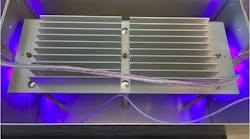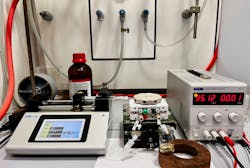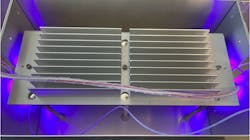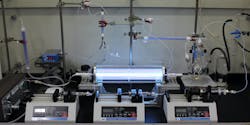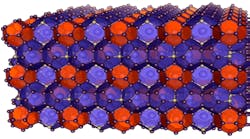Innovative Reactors Show Promise for Chemical Industry
As the molecular complexity of their products increases, pharmaceutical companies face a constant challenge to develop new manufacturing processes that are safe, cost-efficient and sustainable.
It’s an issue that prompted the Enabling Technologies Consortium (ETC) in Washington, DC., to establish its novel chemistry reaction environment working group in 2020.
With representatives from a dozen of ETC’s pharmaceutical and biotechnology companies, the working group brought together chemical engineers and process chemists to share precompetitive knowledge on novel chemical processing technologies and identify common hurdles that inhibit their use.
Their thoughts are crystallized in a recent Chemical Engineering Research and Design article which identifies novel reaction technologies including electrochemistry, photochemistry and biocatalysis as key to future drug development and manufacturing.
It should be no surprise, therefore, that the research community is homing in on such new reaction and reactor technologies.
Electrochemical Microfluidic Reactors
A research group at the University of Geneva (UNIGE) in Switzerland, in collaboration with Cardiff University in Wales, is focusing on a novel application of electrochemical microfluidic reactors that involves using an external electric field like a switch both controls and accelerates chemical reactions taking place within them.
The group’s starting point is that successive organic synthesis steps are crucial for manufacturing drugs and other chemicals, such as polymers and agrochemicals. However, achieving better control and simpler operation of these reactions remains a major research challenge.
“Any molecular transformation results from electrons moving from one place in a molecule to another,’’ explains study lead Stefan Matile, professor in UNIGE’s department of organic chemistry, itself part of the Swiss National Centre of Competence in Research (NCCR) in molecular systems engineering.
He adds that as electrons can be influenced by an external electric field, it is theoretically possible to electrically control chemical reactions.
Although simple in principle and promising in terms of impact, this approach has come up against several limitations, and its few implementations have performed poorly, he notes.
To overcome this, a team led by Matile and Thomas Wirth, professor of organic chemistry at Cardiff University, designed an electrochemical microfluidic reactor that uses oriented external electric fields (OEEFs) to accelerate and direct the flow of charges during molecular transformations.
Writing in Science Advances, the two note that while OEEFs have long been of interest in accelerating chemical reactions in the broadest sense, fundamental challenges have limited progress in organic synthesis in practice.
Their new reactor is a small box in which the reaction mixture can circulate between two electrodes producing the electric field. The electrodes, one platinum, one graphite, are both 5 cm2 and separated by a 0.25-mm fluorinated ethylene propylene spacer containing flow channels resulting in a reactor volume of 0.3 ml, with an exposed electrode surface area of 12 cm2 (Figure 1).
The electrodes are coated with carbon nanotubes. As they flow through the reactor, the reactants interact weakly with the carbon nanotubes, exposing them to the electric field. This induces electronic polarization in the molecule, activating the chemical transformation.
Composed of single-walled carbon nanotubes wrapped around each other to create multi-walled carbon nanotubes. These nanotubes are highly polarizable in local electric fields that are strong enough for catalysis even at low external voltages.
Depending on the orientation of the OEEFs, these fields interact directionally with anionic and cationic parts of reactive intermediates and transition states to accelerate and direct the flow of electrons during the reaction. The result is anion-π and cation-π catalysis, respectively.
Under these conditions, the rate of pyrene-interfaced epoxide-opening ether cyclizations they observed is linearly voltage-dependent at positive voltages and negligible at negative voltages.
“With electrochemical microfluidic reactors, our results show that there is much to win before the electrons jump, shifting attention from radical to supramolecular chemistry, noncovalently electrifying organocatalysis,” they wrote. “Anion-π catalysis and catalysis on carbon nanotubes both move up from specific to general, applicable, in principle, to any organic transformation.”
The article goes on to say that intense ongoing studies are underway to improve pretty much every aspect of the reaction and associated microfluidic reactors. It queries what challenges are posed by, for example, the interfacing of additional co-catalysts on the multi-walled carbon nanotube surface, interfacer engineering, electrode surface modifications and more elaborate electric and flow circuits.
“To me, as an organic chemist, the most attractive are the co-catalysts and their integration because this would also open the door to asymmetric catalysis in a most general way, Matile says. “This is not challenging; it just has to be done and is a bit time consuming like all organic synthesis. The same is true for interfacers, which should, for example, be easily attachable and removable. Hopefully other research groups will try as well.”
He added that progress is promising in other studies currently underway to better understand and improve the electrode surfaces and the electric and flow circuits used in this work.
Facing Up to Optical Purity
In Japan, researchers from Tokyo University of Science have developed a recycling photoreactor to synthesise high yields of optically pure compounds.
Optical purity is a key consideration in pharmaceutical manufacturing as it has a significant impact on a drug’s pharmacological properties.
However, most production processes generate mixtures of optically active compounds known as enantiomers with a 50/50 split between the ones that have desired properties and their mirror images that don’t have them. Together, they are known as a racemic mixture.
This left- and right-handed chirality – so called because of the two ways the different molecules rotate the plane of polarized light – has long posed separation and purification challenges in pharmaceutical manufacturing.
The research team, led by Hideyo Takahashi, professor in the faculty of pharmaceutical sciences, developed a recycling photoreactor that allows the production of enantiomerically pure chiral sulfoxides from a racemic mixture.
The chiral sulfoxides they chose are bioactive molecules used in anti-ulcer drugs.
It’s a two-step process composed of a photoreaction section and a separation section where the racemization and separation occur respectively.
The photoreaction section comprises a glass column containing the photocatalyst 2,4,6-triphenylpyrylium tetrafluoroborate (TPT+) immobilized on a resin, while the separation section consists of a high-performance liquid chromatography (HPLC) column containing a chiral stationary phase that selectively interacts with and separates the desired enantiomer from the racemic mixture (Figure 2).
The cyclic process involves passing the racemic mixture through the HPLC column to separate out the desired enantiomer. The researchers then introduce an unwanted portion into the photoreaction section, where it undergoes photoracemization upon irradiation with light from 405 nm blue LEDs.
They pass the resulting racemic mixture through the HPLC column, which again separates the desired enantiomer. They recycle the remaining undesired enantiomer back to the photoreaction section, and repeat the process until they obtain a high amount of the enantiomerically pure compound.
The researchers successfully synthesized four enantiomerically pure chiral alkyl aryl sulfoxides, achieving optical purity of 98%–99%. They obtained sulfoxides, 2-methoxyethyl phenyl sulfoxide, cyclopropyl phenyl sulfoxide and methoxyphenyl methyl sulfoxide in yields higher than 80% following four to six cycles within the process.
The proposed photoreactor system allows for an efficient and scalable production of enantiomerically pure compounds without the need for chiral components, making it a sustainable technique for the synthesis of low-molecular-weight compounds, such as pharmaceuticals and agrochemicals.
“If these can be manufactured at low cost, it will lead to a stable supply and lower prices for pharmaceuticals and other products,” says Takahashi, adding that the procedure should also be applicable in the enantiospecific preparation of other racemic compounds.
Even so, there are several issues the researchers must resolve, such as avoiding the gradual broadening of the fraction peaks during later cycle runs and preparing suitable separation conditions on the chiral column. If they can address these issues, the scale-up and automatization of this system may yield a powerful tool to generate a pure enantiomer using racemic compounds without a cumbersome stereoselective synthesis or high-cost enantiopurification processes.
An article in the Journal of Organic Chemistry notes that rapid photoracemization on the solid phase was critical to success, and that improvements to the photoreactor system will be reported in due course.
Among the improvements being sought are a reduction in the number of recycling steps needed. “Five cycles are required to produce the enantiomerically pure compound with 96% theoretical yield, but it is difficult to reduce their number. However, it is possible to reduce the number of recycling steps using the deisomerization of diasteremoers,” she adds.
Diastereomers are stereoisomers that are not mirror images of each other and are non-superimposable. They are important in the pharmaceutical industry because manufacturers can use them to create drugs with specific target effects.
Takahashi also believes the process is applicable for large-scale chemical manufacturing.
“The problem to be solved is to introduce a twin column system into the recycling photoreactor,” she says. “Such systems, for example Chromacon’s Contichrom CUBE, are already in practical use. If we have enough money, we could make industrial manufacturing a reality.”
On-Demand Reagent Production
The Vilsmeier reagent (VR), an organic compound with the formula [(CH3)2 NCHCl]Cl, is used in a large range of pharmaceutical manufacturing processes.
However, both VR and its toxic precursor phosgene are unstable in air, making their use in organic syntheses hazardous. So, wherever possible, VR typically is produced on-site and on-demand.
Now, researchers at Kobe University in Japan have developed a flow UV reactor capable of producing VR with phosgene produced from the flow photochemical oxidation of chloroform (Figure 3).
The researchers say the system is applicable to the continuous-flow synthesis of esters, carboxylic anhydrides, amides, aryl aldehyde precursors and β-chloroacrolein precursors. Also, that the confined space in the flow-reaction system is preferable for safe and efficient production.
Akihiko Tsuda, professor in the chemistry department at Kobe University, and his group are leading the research.
Using a UV-based approach, the group earlier achieved production of both phosgene and VR from relatively safe and stable starting chemicals directly in the same vessel as their intended reaction substrates. This means the whole reaction could be achieved as if phosgene or VR were never there.
Initially constrained by its batch-processing nature, this technique faced limitations in terms of scalability. However, the Kobe group has recently introduced a novel flow system for phosgene production, opening up possibilities for the scalable on-demand synthesis of various chemicals that rely on this process.
“Our group discovered for the first time that chloroform, a common organic solvent, underwent photochemical oxidation to form phosgene with high efficiency when irradiated with ultraviolet light,” Tsuda explains. “Our ‘photo-on-demand organic synthesis method’ based on this chemical reaction is a big step for phosgene-based organic synthesis.”
In a study published in Organic Process Research & Development, the group describes its novel process to create a flow system that produces VR on demand from phosgene. They produced the phosgene in the same on-demand flow system from chloroform, a relatively safe and stable starting compound, creating what they describe as a scalable, safe and efficient reaction system to produce a wide range of useful chemicals.
“This reaction system consumes less energy, produces less waste and enables versatile as well as scalable chemical synthesis,” Tsuda notes. “These features contribute positively to the lifecycle assessment of the products, which is especially important in the industry.”
Tsuda, adds that it also enables a more local production of key chemicals, reducing dependence on production abroad.
Tsuda also says the new system is suitable for small-scale, multiproduct chemical synthesis in industry, such as bulk pharmaceuticals and intermediates. For such applications, synthesis on a scale of about 1 kg/day is generally required.
“Synthesis on a larger scale (>10 kg/day) will require the development of synthesis systems and safety equipment,” he says. “We are currently working on the development of a larger-scale system in cooperation with partner companies with the support of Japanese government.”
Tsuda revealed that plans are underway to launch a start-up company based on the work.
“Here, we plan to set up a contract production and co-production business for the phosgenation products,” he says.
Collaboration is Key
Meanwhile, the ETC’s working group-backed Chemical Engineering Research and Design paper notes that a process development group with diverse talents is necessary to realize the adoption of these novel technologies.
“Cross training and collaboration between chemists and chemical engineers and particularly scientists with reaction engineering and process design skill sets, are essential to developing robust, scalable implementation of these new chemistry types,” it concludes.
